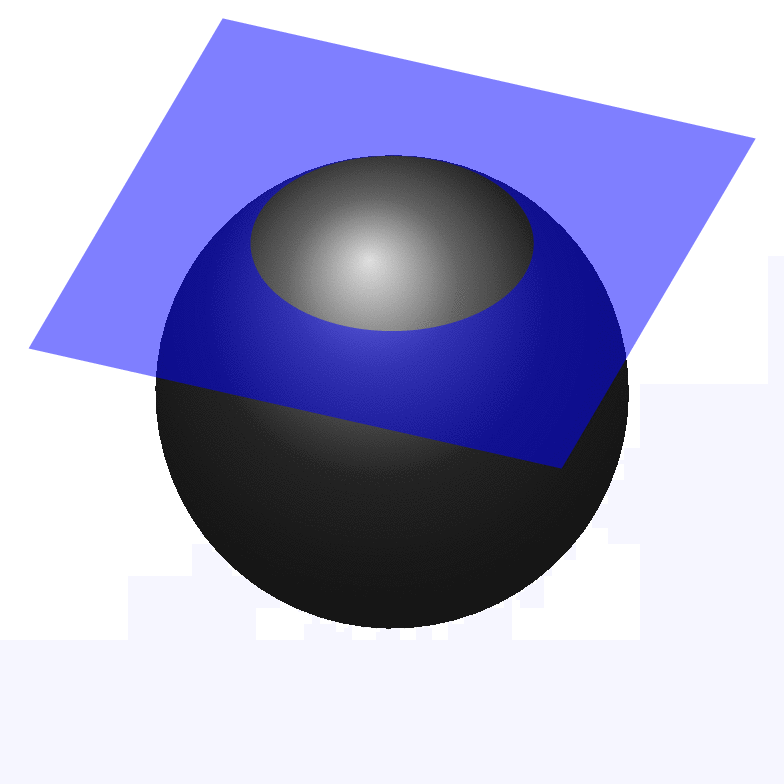This is more a general tool than a concrete answer to the question. This is a prototype of something that let's Ti*k*Z decide whether some stretch of a path is in the foreground or background. The basic point is that whenever you perform an orthographic projection, one can compute the normal on the screen from `\pgf@xx`, `\pgf@xy` and so on, and thus knows how far some object is in the foreground or background by projecting its 3d coordinate on the normal. One can then let Ti*k*Z decompose the path in foreground and background stretches. The following is more a proof of principle than a perfectly working code, though.
````
\documentclass[tikz,border=3mm]{standalone}
\usepackage{tikz-3dplot}
\usetikzlibrary{backgrounds,fpu}
\makeatletter
\newif\iftikz@td@combinestretches
\newcommand{\PgfmathsetmacroFPU}[2]{\begingroup% https://tex.stackexchange.com/a/503835
\pgfkeys{/pgf/fpu,/pgf/fpu/output format=fixed}%
\pgfmathsetmacro{#1}{#2}%
\pgfmathsmuggle#1\endgroup}%
\newcommand{\PgfmathtruncatemacroFPU}[2]{\begingroup% https://tex.stackexchange.com/a/503835
\pgfkeys{/pgf/fpu,/pgf/fpu/output format=fixed}%
\pgfmathtruncatemacro{#1}{#2}%
\pgfmathsmuggle#1\endgroup}%
\pgfmathdeclarefunction{screendepth}{3}{%
\begingroup%
\pgfkeys{/pgf/fpu,/pgf/fpu/output format=fixed}%
\pgfmathparse{%
((\the\pgf@yx)*(\the\pgf@zy)-(\the\pgf@yy)*(\the\pgf@zx))*(#1)+
((\the\pgf@zx)*(\the\pgf@xy)-(\the\pgf@xx)*(\the\pgf@zy))*(#2)+
((\the\pgf@xx)*(\the\pgf@yy)-(\the\pgf@yx)*(\the\pgf@xy))*(#3)}%
\pgfmathsmuggle\pgfmathresult\endgroup%
}%
\tikzset{record plot/.code={%
\tikzset{3d plot/.cd,#1}%
\def\pv##1{\pgfkeysvalueof{/tikz/3d plot/##1}}%
\edef\pgfutil@tempa{0}%
\expandafter\pgfmathsetmacro\csname\pv{variable}\endcsname{\tmin}%
\PgfmathsetmacroFPU{\pgfutil@tempx}{\pv{x}}%
\PgfmathsetmacroFPU{\pgfutil@tempy}{\pv{y}}%
\PgfmathsetmacroFPU{\pgfutil@tempz}{\pv{z}}%
\edef\pgfutil@templ{(\pgfutil@tempx,\pgfutil@tempy,\pgfutil@tempz)}%
\PgfmathtruncatemacroFPU{\pgfutil@tempd}{sign(-\pv{threshold}+screendepth(\pgfutil@tempx,\pgfutil@tempy,\pgfutil@tempz))}%
\edef\pgfutil@tempv{0}% visible index
\edef\pgfutil@temph{0}% hidden index
\ifnum\pgfutil@tempd=-1\relax
\edef\pgfutil@temph{1}%
\expandafter\edef\csname tikz@td@lsthidcoords\pgfutil@temph\endcsname{(\pgfutil@tempx,\pgfutil@tempy,\pgfutil@tempz)}%
\expandafter\edef\csname tikz@td@lsthidcoordsreversed\pgfutil@temph\endcsname{(\pgfutil@tempx,\pgfutil@tempy,\pgfutil@tempz)}%
\edef\pgfutil@temps{-1}% last sign
\else
\edef\pgfutil@tempv{1}%
\expandafter\edef\csname tikz@td@lstviscoords\pgfutil@tempv\endcsname{(\pgfutil@tempx,\pgfutil@tempy,\pgfutil@tempz)}%
\expandafter\edef\csname tikz@td@lstviscoordsreversed\pgfutil@tempv\endcsname{(\pgfutil@tempx,\pgfutil@tempy,\pgfutil@tempz)}%
\edef\pgfutil@temps{1}% last sign
\fi
\loop
\edef\pgfutil@tempa{\the\numexpr\pgfutil@tempa+1}%
\expandafter\PgfmathsetmacroFPU\csname\pv{variable}\endcsname{\tmin+(\tmax-\tmin)*\pgfutil@tempa/\pv{steps}}%
\PgfmathsetmacroFPU{\pgfutil@tempx}{\pv{x}}%
\PgfmathsetmacroFPU{\pgfutil@tempy}{\pv{y}}%
\PgfmathsetmacroFPU{\pgfutil@tempz}{\pv{z}}%
\PgfmathtruncatemacroFPU{\pgfutil@tempd}{sign(-\pv{threshold}+screendepth(\pgfutil@tempx,\pgfutil@tempy,\pgfutil@tempz))}%
\ifnum\pgfutil@tempd=-1\relax
\ifnum\pgfutil@temps=-1\relax
\expandafter\edef\csname tikz@td@lsthidcoords\pgfutil@temph\endcsname{%
\csname tikz@td@lsthidcoords\pgfutil@temph\endcsname (\pgfutil@tempx,\pgfutil@tempy,\pgfutil@tempz)}%
\expandafter\edef\csname tikz@td@lsthidcoordsreversed\pgfutil@temph\endcsname{%
(\pgfutil@tempx,\pgfutil@tempy,\pgfutil@tempz) \csname tikz@td@lsthidcoordsreversed\pgfutil@temph\endcsname}%
\else
\edef\pgfutil@temph{\the\numexpr\pgfutil@temph+1}%
\expandafter\edef\csname tikz@td@lsthidcoords\pgfutil@temph\endcsname{\pgfutil@templ (\pgfutil@tempx,\pgfutil@tempy,\pgfutil@tempz)}%
\expandafter\edef\csname tikz@td@lsthidcoordsreversed\pgfutil@temph\endcsname{(\pgfutil@tempx,\pgfutil@tempy,\pgfutil@tempz) \pgfutil@templ}%
\edef\pgfutil@temps{-1}%
\fi
\else
\ifnum\pgfutil@temps=-1\relax
\edef\pgfutil@tempv{\the\numexpr\pgfutil@tempv+1}%
\expandafter\edef\csname tikz@td@lstviscoords\pgfutil@tempv\endcsname{\pgfutil@templ (\pgfutil@tempx,\pgfutil@tempy,\pgfutil@tempz)}%
\expandafter\edef\csname tikz@td@lstviscoordsreversed\pgfutil@tempv\endcsname{(\pgfutil@tempx,\pgfutil@tempy,\pgfutil@tempz)
\pgfutil@templ}%
\edef\pgfutil@temps{1}% last sign
\else
\expandafter\edef\csname tikz@td@lstviscoords\pgfutil@tempv\endcsname{%
\csname tikz@td@lstviscoords\pgfutil@tempv\endcsname (\pgfutil@tempx,\pgfutil@tempy,\pgfutil@tempz)}%
\expandafter\edef\csname tikz@td@lstviscoordsreversed\pgfutil@tempv\endcsname{%
(\pgfutil@tempx,\pgfutil@tempy,\pgfutil@tempz) \csname tikz@td@lstviscoordsreversed\pgfutil@tempv\endcsname}%
\fi
\fi
\edef\pgfutil@templ{(\pgfutil@tempx,\pgfutil@tempy,\pgfutil@tempz)}% last coord
\ifnum\pgfutil@tempa<\pv{steps}\relax
\repeat
\iftikz@td@combinestretches
\ifnum\pgfutil@tempv>1
\expandafter\edef\csname tikz@td@lstviscoords1\endcsname{%
\csname tikz@td@lstviscoords\pgfutil@tempv\endcsname
\csname tikz@td@lstviscoords1\endcsname}%
\expandafter\edef\csname tikz@td@lstviscoordsreversed1\endcsname{%
\csname tikz@td@lstviscoordsreversed1\endcsname
\csname tikz@td@lstviscoordsreversed\pgfutil@tempv\endcsname
}%
\edef\pgfutil@tempv{\the\numexpr\pgfutil@tempv-1}%
\fi
\ifnum\pgfutil@temph>1
\expandafter\edef\csname tikz@td@lsthidcoords1\endcsname{%
\csname tikz@td@lsthidcoords\pgfutil@tempv\endcsname
\csname tikz@td@lsthidcoords1\endcsname
}%
\expandafter\edef\csname tikz@td@lsthidcoordsreversed1\endcsname{%
\csname tikz@td@lsthidcoordsreversed1\endcsname
\csname tikz@td@lsthidcoordsreversed\pgfutil@tempv\endcsname
}%
\edef\pgfutil@temph{\the\numexpr\pgfutil@temph-1}%
\fi
\fi
\tikzset{3d plot/.cd,visible stretches/.expanded=\pgfutil@tempv,
hidden stretches/.expanded=\pgfutil@temph}%
}}
\tikzset{3d plot/.cd,x/.initial=0,y/.initial=0,z/.initial=0,
tmin/.store in=\tmin,tmax/.store in=\tmax,steps/.initial=100,
domain/.code args={#1:#2}{\def\tmin{#1}\def\tmax{#2}},
domain/.initial=0:1,
variable/.code=\let#1\tikz@td@t,
variable/.initial=t,threshold/.initial=0,
visible stretches/.initial=0,hidden stretches/.initial=0,
combine stretches/.is if=tikz@td@combinestretches,
combine stretches=true,
save visible stretch/.code 2 args={\edef#2{\csname tikz@td@lstviscoords#1\endcsname}},
save hidden stretch/.code 2 args={\edef#2{\csname tikz@td@lsthidcoords#1\endcsname}},
save reversed visible stretch/.code 2 args={\edef#2{\csname tikz@td@lstviscoordsreversed#1\endcsname}},
save reversed hidden stretch/.code 2 args={\edef#2{\csname tikz@td@lsthidcoordsreversed#1\endcsname}},
}%
\makeatother
\begin{document}
\foreach \X in {5,15,...,355}
{\begin{tikzpicture}[declare function={R=5;
Rplane(\t)=1/max(abs(cos(\t)),abs(sin(\t)));},
bullet/.style={circle,fill,inner
sep=2pt}]
\shade[ball color = black!80,transform canvas={rotate=-35}] (0,0,0) circle[radius=R];
\tdplotsetmaincoords{50+20*sin(\X)}{110}
\begin{scope}[tdplot_main_coords]
\path[tdplot_screen_coords,use as bounding box] (-8,-8) rectangle (8,8);
\tikzset{record plot={x={3*cos(\t)},y={3*sin(\t)},z=4,domain=0:360,variable=\t}}
\edef\mystretches{\pgfkeysvalueof{/tikz/3d plot/visible stretches}}
\edef\myhidstretches{\pgfkeysvalueof{/tikz/3d plot/hidden stretches}}
\ifnum\mystretches=1
\tikzset{3d plot/save visible stretch={1}{\LstVis}}
\tikzset{3d plot/save reversed visible stretch={1}{\LstVisReversed}}
\fi
\ifnum\myhidstretches=1
\tikzset{3d plot/save hidden stretch={1}{\LstHid}}
\tikzset{3d plot/save reversed hidden stretch={1}{\LstHidReversed}}
\fi
%
\tikzset{record
plot={x={6*Rplane(\t)*cos(\t)},y={6*Rplane(\t)*sin(\t)},z=4,domain=45:405,variable=\t}}
\edef\myvisstretchesPlane{\pgfkeysvalueof{/tikz/3d plot/visible stretches}}
\edef\myhidstretchesPlane{\pgfkeysvalueof{/tikz/3d plot/hidden stretches}}
\ifnum\myvisstretchesPlane=1
\tikzset{3d plot/save visible stretch={1}{\LstVisPlane}}
\fi
\ifnum\myhidstretchesPlane=1
\tikzset{3d plot/save hidden stretch={1}{\LstHidPlane}}
\fi
\pgfmathtruncatemacro\itest{\mystretches+2*\myhidstretches+4*\myvisstretchesPlane}
\ifcase\itest % 0: nothing in foreground
\or % 1: circle completely in foreground, plane completely in background (should not happen)
\message{Circle is completely in foreground and the plane completely in background,
but this should not happen.^^J}%
\or % 2: circle completely in background, plane completely in background
\or % 3: circle partly in background, plane completely in background
\message{Circle is partly in foreground and the plane completely in background,
but this should not happen.^^J}%
\or % 4
\path[fill=blue,fill opacity=0.5] plot coordinates{\LstVisPlane};
\or % 5 circle completely in foreground
\path[fill=blue,fill opacity=0.5,even odd rule] plot coordinates{\LstVisPlane}
-- plot coordinates{\LstHidPlane} -- cycle
plot[smooth cycle] coordinates{\LstVis};
\or % 6
\or % 7 circle has visible and hidden stretches, so has plane
\begin{scope}[on background layer]
\path[fill=blue,fill opacity=0.5] plot coordinates{\LstHidPlane}
-- plot coordinates{\LstHidReversed} -- cycle;
\end{scope}
\path[fill=blue,fill opacity=0.5,even odd rule] plot coordinates{\LstVisPlane}
-- plot coordinates{\LstVisReversed} -- cycle;
\fi
\end{scope}
\end{tikzpicture}}
\end{document}
````

Let me mention that similar things have been achieved for specific situations, in particular for paths on a sphere. The new thing here is that this works for arbitrary paths, also for ellipsoids and so on and so forth. I also have not had the patience of treating all possible cases.